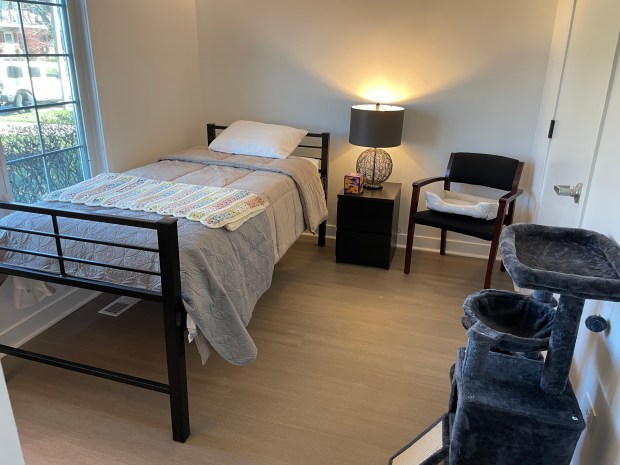Rebeca Groh said it took her seven years to leave an abusive relationship.
Hers was a financial-abuse situation in which, over time, she said her fiancé diminished her capacity to support herself and she was forced to depend on him. For example, the mother of three said he was in charge of her disability assistance.
“He was never gonna change,” Groh said. “I was tired of living that way.”
Having had no economic resources for so long, Groh reached out to A Safe Place for help.
The domestic abuse center was able to provide her shelter for her, her daughters and another important family member — her service dog Gigi.
In the past, that would not have happened. Without the resources pets need at the shelter, clients had to board their furry companions at a different location. They were safe, but separated.
Now, through the Safe Paws pet shelter program, clients have another option. They’re able to be housed together at the agency’s emergency and transitional shelters. They’re provided with items pets need, and they have access to basic veterinary care.
That is significant because research shows that perpetrators of domestic abuse often exploit the bond a victim can have with their pet.
“Abusers use beloved pets to control, manipulate, frighten and punish their victims,” said Christine Lucheck, chief of residential services at A Safe Place.
According to the National Link Coalition, a nonprofit agency that serves as a global resource center on the link between animal abuse and humans, in 2021, 97% of callers to the National Domestic Violence hotline said that keeping their pets with them is an important factor in deciding whether or not to seek shelter.
Their reporting also showed that 50% of the callers said they would not consider a shelter for themselves if they couldn’t take their pets with them.
“We’ve been missing a huge population,” Lucheck said. “The need for this type of program has always been there.”
So much so that a significant provision of the bipartisan Pet and Women Safety Act, signed into law in 2018, included a grant program for entities that provide shelter and housing assistance for domestic violence survivors.
It’s thanks to that grant that A Safe Place was able to fully launch the pet shelter program. The $400,000 grant allowed the agency to modify space in its emergency shelter, where two bedrooms were made pet-friendly and another area was converted to have a wash station. Outside, there will soon be a dog run.
At their transitional housing apartments, pets are also welcome.

By providing these secure spaces for both humans and their pets, the Safe Paws program chips away at one of the many roadblocks clients face when they’re trying to escape domestic abuse.
Even in cases where victims have escaped their abusers, perpetrators can threaten that they’ll harm or kill the pet if they don’t come back. Violence is also inflicted on pets.
In the fall of 2023, when the program was just starting, Lucheck said a woman escaped a traumatic domestic violence situation and arrived at A Safe Place with her 14-year-old Boston Terrier.
The client received therapeutic support and over time began healing from the extensive physical, emotional, and psychological abuse that was inflicted by her partner, Lucheck said.
Unfortunately, the abuse hadn’t only been directed at her.
“It was clear that (the dog) had repeatedly suffered violent treatment, which included being thrown against walls, kicked and shouted at, which left him with intense anxiety and a deep fear of unfamiliar people,” Lucheck said.
In addition to trauma, the dog suffered from severe dental issues; teeth were missing or falling out, likely due to years of dental neglect or knocked out during episodes of abuse, she said.
The dog received dental care, a full wellness evaluation and vaccinations. Beyond medical treatment, A Safe Place also provided the client with essential pet items. Lucheck said the two are now both healing.
Another story that Lucheck shares is of a touching moment when a client who hadn’t been allowed by her abuser to groom her pet was overcome with emotion when she could finally bathe her dog at the shelter.
Helping families escape domestic abuse has many dimensions.
An alarming connection between pet abuse and domestic violence puts a spotlight on the cycle of abuse.
“Children who have been maltreated, or have witnessed violence, are more likely to abuse animals,” said Claire Coughlin, director of the Companion Animal Program at the Animal Welfare Institute. The Washington, D.C.-based organization studies that link as part of its mission to alleviate animal suffering caused by people.
Couhlin said child abuse and animal abuse frequently occur in the same family, so it makes sense to have wraparound services and resources for all who suffer this abuse.
The Pet and Women Safety Act gives law enforcement an additional tool to protect victims and their pets from their abusers. It allows for orders of protection to also include animals.
Lucheck said the community can help by learning about the link between animal abuse and domestic violence and spreading awareness.
People can also donate pet items, such as leashes, potty pads, metal bowls, treats, toys and pet supply store gift cards during a pet donation campaign that runs through May.
As of late March, A Safe Place had provided services for 52 clients and 65 pets through the Safe Paws program.





